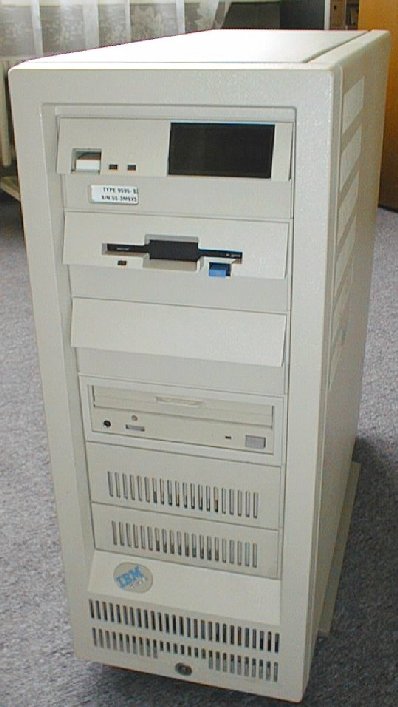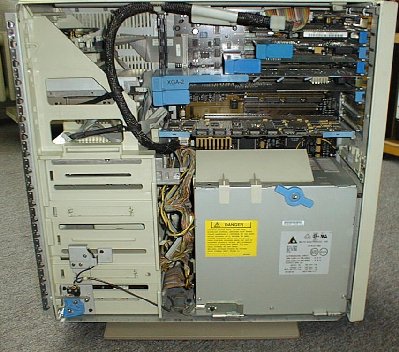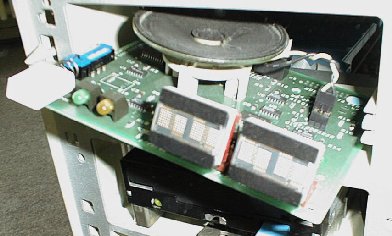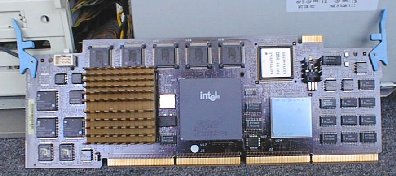
Click here or click onto the photo for a full size version of this picture.
Though there was also a 486-66-based Type 4 complex, most Type 4 processor complexes made by IBM are based on the Intel Pentium. While originally only the 5-Volt versins with 60 or 66 MHz were available, IBM later made another complex based on a P90 that was available as an upgrade for the Model 95. The Pentium-based complexes are the most advanced complexes ever made, since they are the only complexes allowing Synchrostream transfers, and PS/2 machines based on them are one of the highlights of Microchannel development, shortly before IBM dropped the MCA architecture at all.

Click here or click onto the photo for
a full size version of this picture.
A machine designed for a Pentium-based complex can quickly be identified by the additional plastic airflow director placed on the power supply. Especially the 60/66 MHz version of the Pentium produces a lot of heat, and this part is needed to direct the airflow made by the fan in the side cover towards the processor's heatsink. You therefore shouldn't operate this machine too long with the cover open!
As usual, the power supply may be swung out to get access to the memory module sockets. 8 sockets may take up to 8 MByte Parity or 32 MByte ECC modules.

Click here or click onto the photo for
a full size version of this picture.
All Type-4-based 95's with the redesigned planar also have a new operator panel. It is immediately visible that the hard disk LED missing from the old panel is now there. In turn, the superfluous second switch, an artifact on the old panel, has been removed. The panel contains additional logic and is directly connected to the CPU board with an separate cable. This cable probably provides the capability to turn itself on at preprogrammed times.

Click here or click onto the photo for
a full size version of this picture.
The CPU board is dominated by 2 Intel chips, the CPU (hidden below a heatsink) and the Intel 496 cache controller. The row of smaller chips on the PCB's top edge are the cache RAMs, another set is on the back side. Sadly to say, the 496 cache controller is the reason why you can't use the 120/133 MHz overdrive chip later offered by Intel: It internally uses a P54C core with a 5->3.3V regulator, and its signals only have 3.3V logic levels. The 496 is not 3.3V-compliant! There were some attempts with the 497, its successor for 3.3V-based Pentiums, but they have not resulted in very stable systems so far :-(
The blue chip in the right half is the Synchrostream controller.
- Processor:
- Intel Pentium @ 60 MHz
- Coprocessor:
- integrated into CPU
- Cache:
- 2x8K internally in CPU, externally 256K L2 Cache
- Memory:
- 64 Mbytes (options range from 8M to 64M/256M)
- Bus:
- 8 MCA slots (32 bit)
- Interfaces (onboard):
-
- Mouse, Keyboard
- 2 x Serial
- 2 x Parallel
- Floppy (1.44M), allows attachment of up to 3(!) drives
- Add-on cards:
-
- IBM Fast/Wide SCSI Controller
- IBM Fast SCSI Adapter/A
- IBM XGA-2 Graphics Adapter
- IBM Multiprotocol Adapter
- IBM 16/4 Token Ring Adapter
- 3COM 3C529 Ethernet Adapter
- Operating System(s):
-
- Caldera OpenDOS 7.01
- Linux 2.2 (Slackware-based)
- Useful Links: